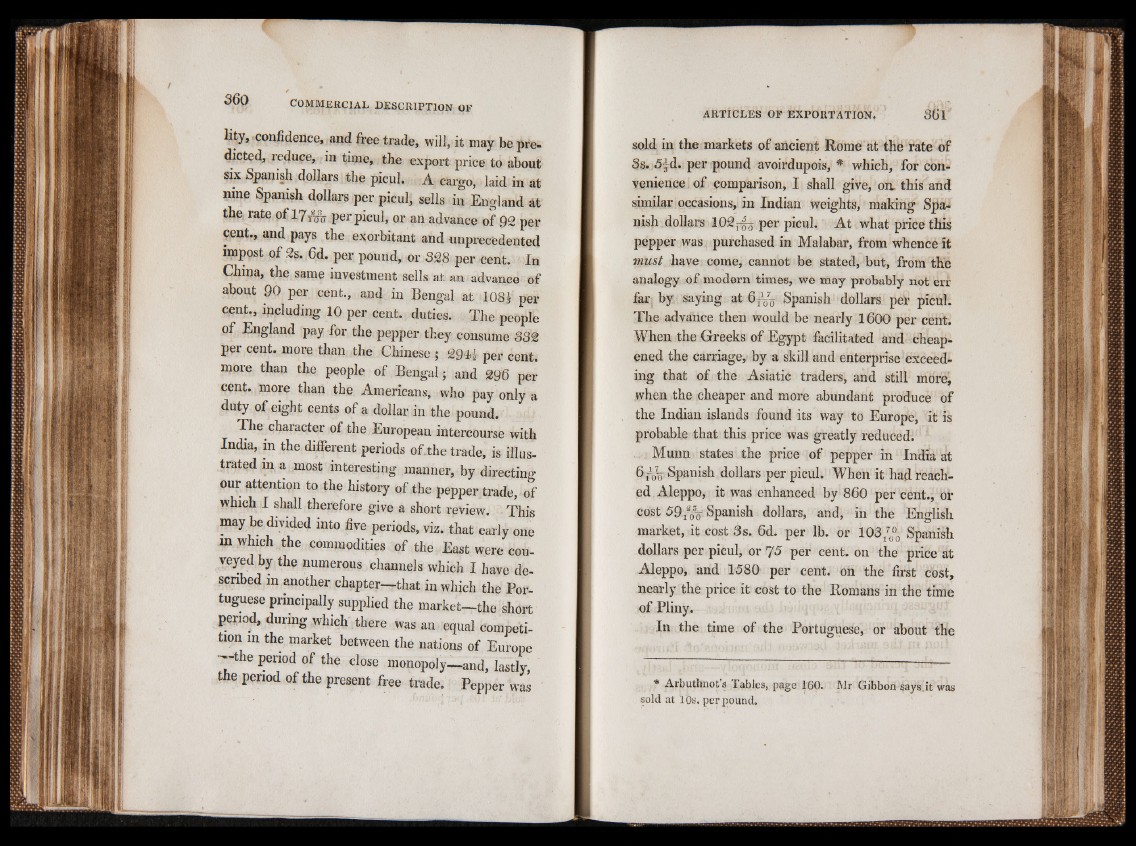
lhy, confidence,^ and free trade, will, it may be predicted,
reduce, in time, the export price to about
six Spanish dollars the picul. A cargo, laid in at
nine Spanish dollars per picul, sells in England at
the rate of 17/^ per picul, or an advance of 92 per
?ent., and pays the exorbitant and unprecedented
impost of 2?. 6d. per pound, or 328 per cent. In
China, the same investment sells at an advance of
about 90 per cent., and in Bengal at 108$ per
cent., including 10 per cent, duties. The people
of England pay for the pepper they consume 332
per cent, more than the Chinese ; 294* per cent,
more than the people of Bengal; and 296 per
cent, more than the Americans, who pay only a
duty of eight cents of a dollar in the pound.
The character of the European intercourse with
India, m the different periods of.the trade, is illustrated
in a most interesting manner, by directing
our attention to the history of the pepper trade, of
which I shall therefore give a short review. This
inay be divided into five periods, viz. that early one
in which the commodities of the East were conveyed
by the numerous channels which I have described
m another chapter—that in which the Portuguese
principally supplied the market-the short
period, during which there was an equal competition
m the market between the nations of Europe
—the period of the close monopoly—and, lastly,
the period of the present free trade. Pepper was
sold in the markets of ancient Rome at the rate of
Ss. 5§fi. per pound avoirdupois, * which, for convenience
of comparison, I shall give, on. this and
similar occasions, in Indian weights, making Spanish
dollars 1 0 2 ^ per picul. At what price this
pepper was purchased in Malabar, from whence it
must have come, cannot be stated, but, from the
analogy of modern times, we may probably not err
far by saying at 6 ^ Spanish dollars per picul.
The advance then would be nearly 1600 per cent.
When the Greeks of Egypt facilitated and cheapened
the carriage, by a skill and enterprise exceeding
that of the Asiatic traders, and still more,
when the cheaper and more abundant produce of
the Indian islands found its way to Europe, it is
probable that this price was greatly reduced.
Munn states the price of pepper in India at
Spanish dollars per picul. When it had reached
Aleppo, it was enhanced by 860 per cent., or
cost 59iw Spanish dollars, and, in the English
market, it cost 3s. 6d. per lb. or 103/000 Spanish
dollars per picul, or 75 per cent, on the price at
Aleppo, and 1580 per cent, on the first cost,
nearly the price it cost to the Romans in the time
of Pliny.
In the time of the Portuguese, or about the
* Arbuthnot s Tables, page 160. Mr Gibbon says it was
sold at 10s. per pound.